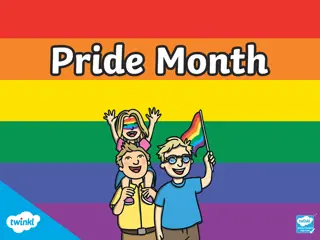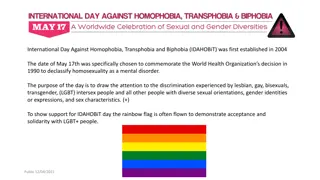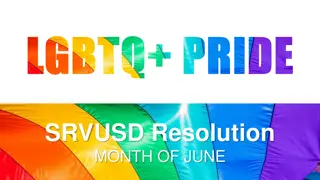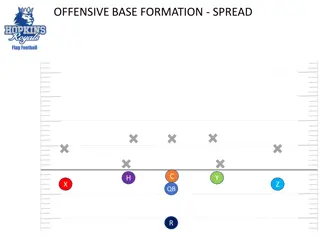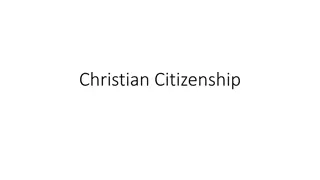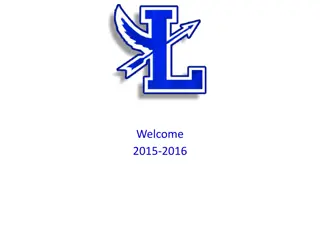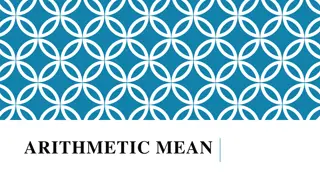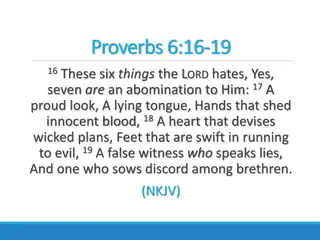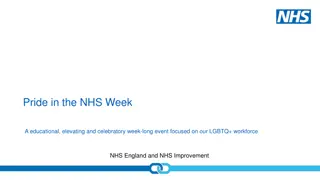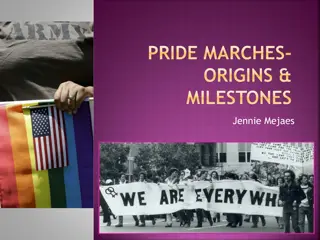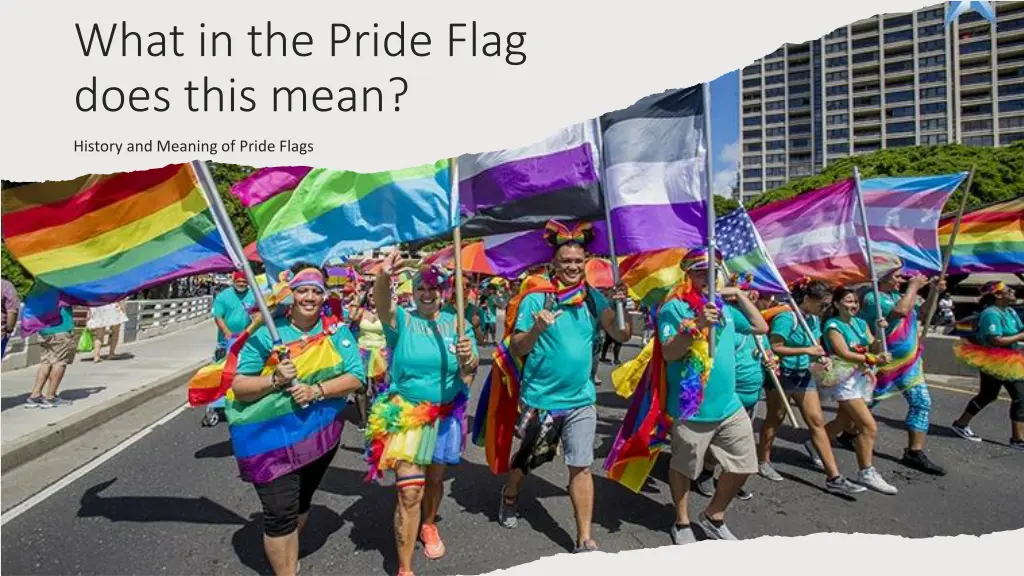
Pride Flags: History and Meanings
Explore the history and meanings of various pride flags, from the original eight-striped Gay Pride Flag to newer flags like the Bear Pride Flag, Bisexual Pride Flag, Labrys Lesbian Flag, and Trans Pride Flag. Each flag carries unique symbolism and represents different aspects of the LGBTQ+ community's diversity and identity.
Uploaded on | 0 Views
Download Presentation

Please find below an Image/Link to download the presentation.
The content on the website is provided AS IS for your information and personal use only. It may not be sold, licensed, or shared on other websites without obtaining consent from the author. If you encounter any issues during the download, it is possible that the publisher has removed the file from their server.
You are allowed to download the files provided on this website for personal or commercial use, subject to the condition that they are used lawfully. All files are the property of their respective owners.
The content on the website is provided AS IS for your information and personal use only. It may not be sold, licensed, or shared on other websites without obtaining consent from the author.
E N D
Presentation Transcript
What in the Pride Flag does this mean? History and Meaning of Pride Flags
First Pride Flag - 1978 Gilbert Baker created the gay pride flag in 1978 Originally had eight stripes: Hot pink to represent sexuality Red for healing Yellow for sun Green for serenity with nature Turquoise for art Indigo for harmony Violet for spirit
Pride Flag 2.0 - 1979 The flag has been reduced to six colors: Because of production issues, the pink and turquoise stripes were removed Indigo was replaced by basic blue, which resulted in the contemporary six-striped flag
Bear Pride Flag - 1995 Created by Craig Byrnes The gay bear culture celebrates secondary sex characteristics such as growth of body hair and facial hair, which is typically considered a "bear" trait. The colors represent the fur colors and nationalities of bears throughout the world and the flag was designed with inclusivity in mind.
Bisexual Pride Flag - 1998 Created by Michael Page The pink is intended to represent attraction to the same sex only The royal blue to the opposite sex only The purple attraction to all genders / more than one.
Labrys Lesbian Flag - 1999 Created by Sean Campbell The flag is a symbol for the lesbian feminist community. The labrys was adopted in the 1970s by lesbian feminists as a symbol representing strength, empowerment, and female divinity The color violet became associated with lesbians through the representation of the violet flower as a symbol of lesbian love, which originates from a poem by Sappho The inverted black triangle originated in Nazi Germany. Similar to the pink triangle design, the black triangle was used in concentration camps to designate prisoners with anti-social behavior, which included lesbians. Some lesbians reclaimed this symbol as gay men reclaimed the pink triangle
Trans Pride Flag - 1999 Created by Monica Helms, an openly transgender American woman The light blue and pink are the traditional colors for baby girls and baby boys The white represents intersex, transitioning, or a neutral or undefined gender. The flag is symmetrical so no matter which way you fly it, it is always correct, signifying us finding correctness in our lives.
Lipstick Lesbian Flag - 2010 Created by Natalie McCray The term "lipstick lesbian" has been met with controversy. Some authors have commented that the term lipstick lesbian is commonly used broadly to refer to feminine bisexual women or to heterosexual women who temporarily show romantic or sexual interest in other women to impress men
Lesbian Pride Flag - 2010 Created by Emily Gwen A Lesbian Flag for Everyone This flag retained the seven stripes from the lipstick flag, but changed the top set to orange shades. Dark Orange - Represent gender non-conformity Orange - independence Light Orange - community White - unique relationships to womanhood Pink - serenity and peace Dusty Pink - love and sex Dark Rose - femininity
Pansexual Pride Flag - 2010 Created by unknown According to most definitions, The pink represents attraction to people who are female identified The blue represents attraction to people who are male identified The yellow represents nonbinary attraction
Asexual Pride Flag - 2010 Created by The flag was created by Asexual Visibility and Education Network The black stripe represents asexuality The grey stripe represents the grey-area between sexual and asexual The white stripe represents sexuality The purple stripe represents community.
Genderqueer Pride Flag - 2011 This flag was designed by Marilyn Roxie, a genderqueer writer and advocate The lavender stripe is a mix of blue and pink colors traditionally associated with men and women and represents androgyny as well as queer identities. The white stripe, like in the transgender pride flag, represent agender or gender-neutral identities. The chartreuse stripe is the inverse of lavender and represents third gender identities and identities outside the gender binary.
Genderfluid Pride Flag - 2012 JJ Poole created this flag Pink for femininity Blue for masculinity Purple for both masculinity and femininity Black for the lack of gender White for all genders.
Intersex Pride Flag - 2013 Created by Morgan Carpenter. The color yellow has long been regarded as an intersex color, neither blue nor pink. Purple, too, has been used for the same purpose. The circle is unbroken and unornamented, symbolizing wholeness and completeness, and our potentialities. We are still fighting for bodily autonomy and genital integrity, and this symbolizes the right to be who and how we want to be.
Nonbinary Pride Flag - 2014 Kye Rowan created the nonbinary pride flag It is intended to represent nonbinary people who did not feel that the genderqueer flag represents them The yellow stripe represents people whose gender exists outside of the binary The white stripe represents people with many or all genders The purple stripe represents people with genders considered a mix of male and female The black strip represents people who identify as not having a gender.
Agender Pride Flag - 2014 Created by Salem X The black and white stripes represent an absence of gender The gray stripes represent semi- genderlessness The central green stripe represents nonbinary genders.
Aromatic Pride Flag - 2014 This flag was designed by Cameron Whimsy Dark Green: Represents aromanticism. Light Green: Represents the aromantic spectrum. White: Represents platonic and aesthetic attraction, as well as queer/quasi platonic relationships. Grey: Represents grey- aromantic and demiromantic people. Black: Represents the sexuality spectrum.
Pride Flag 3.0 - 2018 This is a rebooted pride flag by Daniel Quasar. Representation matters especially for the most marginalized communities. The reboot is meant to be inclusive of queer people of color and trans people.
Why a Flag? Baker, creater of the first Gay Pride Flag, later revealed that he was urged by Harvey Milk, one of the first openly gay elected officials in the U.S., to create a symbol of pride for the gay community. Baker decided to make that symbol a flag because he saw flags as the most powerful symbol of pride. Our job as gay people was to come out, to be visible, to live in the truth, as I say, to get out of the lie. A flag really fit that mission, because that s a way of proclaiming your visibility or saying, This is who I am!
Apologies if you didnt see a flag that you know should be here! Please let us know what we should add! Design your own Flag! Pull out a piece of paper and some coloring tools and design a flag. Use colors that represent your gender identity, sexuality, values, and anything else! No paper? No problem! Try out this website to make a virtual flag https://tennessine.co.uk/flags/
Example Flag Incorporated colors of the Bisexual, Asexual, and Pansexual Pride Flags Blue to represent attraction to males Pink to represent attraction to females Yellow to represent attraction to nonbinary Black to represent sexuality spectrum Green to represent serenity with nature Purple stripe to represent community. Moon phases to show that sexuality is fluid Wave to reinforce fluidity

